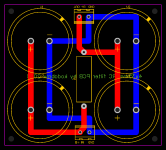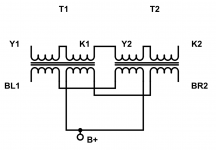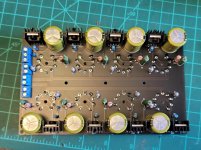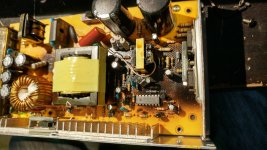Oh nice. That'll make things easier.
I have PS RC filter boards that might interest you. Nothing fancy, just 2 35mm caps in parallel, a resistor, and two more 35mm caps. Right now, I have one set up with 4x330u, and 5R1. I have two designs, one is square, the other is long rectangular. Cap spacing is for 10mm snap-ins. 5$ a piece.
I have PS RC filter boards that might interest you. Nothing fancy, just 2 35mm caps in parallel, a resistor, and two more 35mm caps. Right now, I have one set up with 4x330u, and 5R1. I have two designs, one is square, the other is long rectangular. Cap spacing is for 10mm snap-ins. 5$ a piece.
Attachments
I'm also gonna send this one off if you prefer to have the diodes onboard. It'll cost 10$ though since it's longer, but I'll throw in the diodes?
It'll arrive with the other boards.
It'll arrive with the other boards.
Attachments
Last edited:
I get over 12W out of a pair of 6P1P in PP. You should be able to get well over 35W out of eight in PPP.
If anyone is interested, I designed the output stage into a circuit board.
Want a pair?
crawls out from under a rock
NICE!!!😎
Did you do that with EasyEDA?
I've had a whirlwind of health issues this last year, and just bought a house. Just got over COVID (!), back to work finally, and contemplating the next build after I finish a couple current ones. May have to grab a case of 6P1P to try this out now that PCBs are around 🙂
I started having enough problems with my hands that I was making too many mistakes to keep designing PCBs. I'm going to try to get back into them soon.
If anyone is interested, I designed the output stage into a circuit board.
Want a pair?
Yes!
Wow, you've been busy coming up with cool projects. I bought a bunch of 6P1P tubes a while ago. I should put them to good use. I figure PPP 6P1P-triode would work fine with 5k p-p primary. Lower power but more damping, which is how I like it.
It's 4PP so 8 tubes/channel - I'm going with interleaved VPT12-4170 or VPT12-8830 so ~1k5:4R, 2k2:6R, 3k:8R... All well within the Class A envelope.
The only thing the larger coils will get me is slightly more power due to lower DCR.
I'll probably drive them with my 6F12P VA/PI board - I don't think I'll need the 6N8S driver.
Also, I just realized I didn't answer Linwendil's question. Yes, I'm using EasyEDA.
The only thing the larger coils will get me is slightly more power due to lower DCR.
I'll probably drive them with my 6F12P VA/PI board - I don't think I'll need the 6N8S driver.
Also, I just realized I didn't answer Linwendil's question. Yes, I'm using EasyEDA.
Given the fact you've worked with both, what do you think the sound is like comparing triode connected 6p1p vs 6p43p-e? I have twenty one (!) 6p43p-e on hand and after our previous discussions think they may work well for something like this. maybe a 4x4 amplifier (each channel is parallel push pull triode connecter, one pair per phase) arranged like a V8 engine may be a fun build with them using those 6f12p you sent me a while back to drive the front end. 250 volts supply for the output stage. maybe 15-20 watts output you think?
It's 4PP so 8 tubes/channel
How much plate current per tube? Do you use them with lower dissipation for cooler operation, longer life? Or do you roast them at >10W Ip per tube?
This is a great excuse to get a couple of low impedance OPTs, which should theoretically yield wider bandwidth than the usual 5k, 6.6k or 8k plate-plate impedance.
I figure the rp of a triode-wired 6P1P will be about 2k ohms.
Divide that by 8 and you get a really low 300 ohms.
Even 1k plate-plate impedance would be in play. I think I'd double that, though.
2k to 4 ohms?
--
Given the fact you've worked with both, what do you think the sound is like comparing triode connected 6p1p vs 6p43p-e? I have twenty one (!) 6p43p-e on hand and after our previous discussions think they may work well for something like this. maybe a 4x4 amplifier (each channel is parallel push pull triode connecter, one pair per phase) arranged like a V8 engine may be a fun build with them using those 6f12p you sent me a while back to drive the front end. 250 volts supply for the output stage. maybe 15-20 watts output you think?
The 6P43P kicks le cul! Expect 30+ watts from 4PP with the right load (like 600R)
How much plate current per tube? Do you use them with lower dissipation for cooler operation, longer life? Or do you roast them at >10W Ip per tube?
This is a great excuse to get a couple of low impedance OPTs, which should theoretically yield wider bandwidth than the usual 5k, 6.6k or 8k plate-plate impedance.
I figure the rp of a triode-wired 6P1P will be about 2k ohms.
Divide that by 8 and you get a really low 300 ohms.
Even 1k plate-plate impedance would be in play. I think I'd double that, though.
2k to 4 ohms?
--
They are set for like 41mA with the default set resistor for about 11W or so Pd.
With the 6P1P, you're current limited unless you drive the grid positive. With 6P43P, you'll get more current into the load "out of the box".
If there's enough interest, I'll make a 6P43P version of this board. I started to yesterday, but didn't feel like rewiring the thing lol
2k to 4k should be fine. I'll be running ~2k2:6R
Consider trying the interleaved OPT method using a pair of toroidal PTs.
For 160$CAD plus tax, you get iron for both channels, great response, low DCR, and low phase variance (more gNFB can be applied).
Blocked
Thanks koda! Very clever use of inexpensive parts here.
Can you point us to an explanation of how to do this? Do you use two toroid PTs per channel, so four toroid PTs required to wire up the OPTs for a stereo amp? How do you wire those to get the desired result?
I was thinking of simply having Edcor or Transcendar make something, but Antek or other toroidal PTs are certainly an interesting option. I'm up for an experiment...
Consider trying the interleaved OPT method using a pair of toroidal PTs.
Can you point us to an explanation of how to do this? Do you use two toroid PTs per channel, so four toroid PTs required to wire up the OPTs for a stereo amp? How do you wire those to get the desired result?
I was thinking of simply having Edcor or Transcendar make something, but Antek or other toroidal PTs are certainly an interesting option. I'm up for an experiment...
Black sure does look slick!
Doesn't it? And it won't discolour from the heat like this SMPS I cooked until the magic smoke came out.
Attachments
Last edited:
- Home
- Amplifiers
- Tubes / Valves
- The "Stupendous" 6P1P 4PP amplifier!





